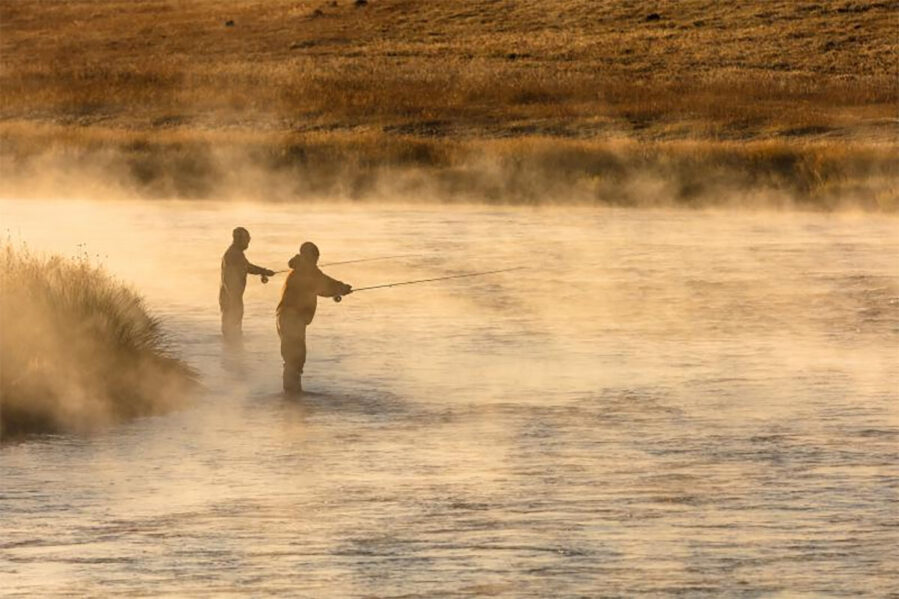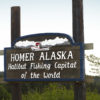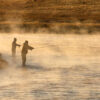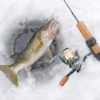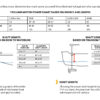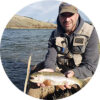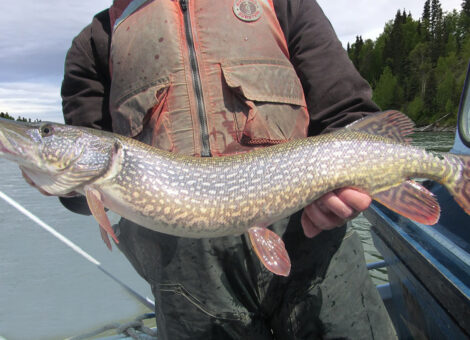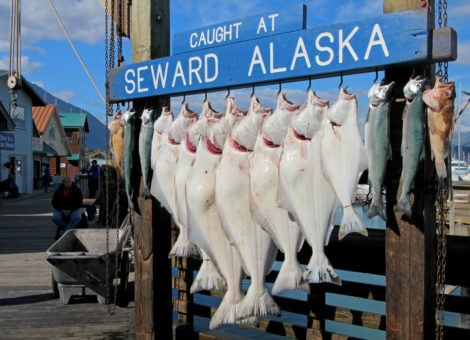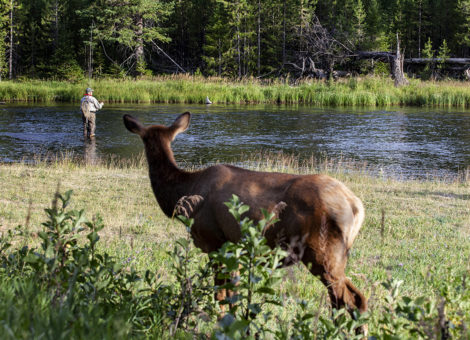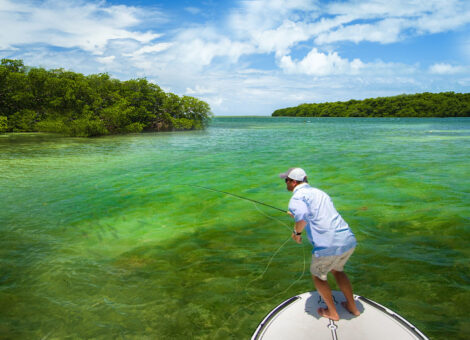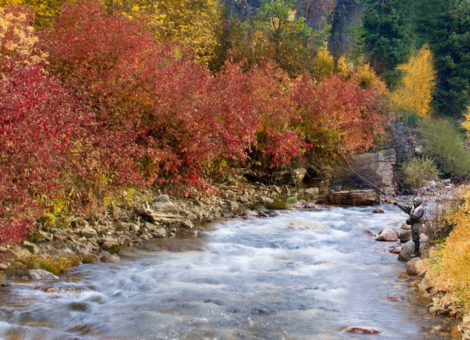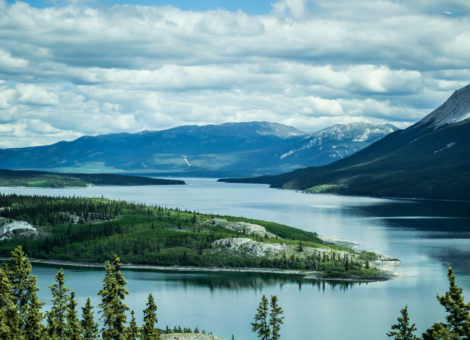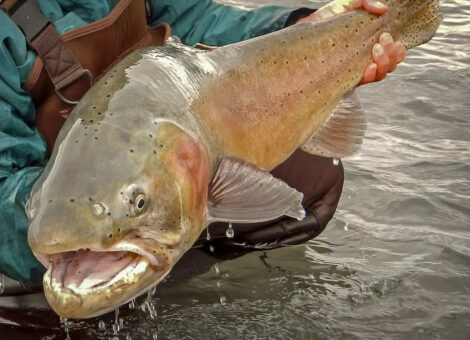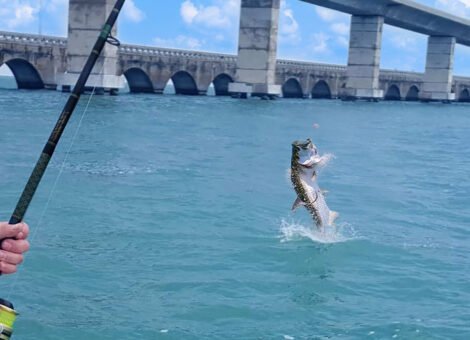The Madison River is formed by the confluence of Gibbon and Firehole Rivers in west central Yellowstone National Park. From the Gibbon Firehole confluence—aka Madison Junction—the Madison river extends west 14 miles and then runs north 132 miles where it joins the Gallatin and Jefferson rivers near Three Forks, Montana at its confluence of the Missouri River.
The Madison River has three distinct fisheries, the Upper Madison (“Yellowstone”), Upper Middle Madison and Lower Madison. Each fishery provides anglers unique habitat, hatches, and fishing techiques. The Upper Madison fishery extends from Madison Junction west to Yellowstone Park Boundary passing through Hebgen and Quake lakes to Raynolds Pass. The Upper Middle Madison continues north to Ellis Lake. The Lower Madison extended from Ellis Lake north to its confluence with Montana’s Missouri River.
Each fishery within the Madison River experiences peak fishing seasons, but there is always a section along the Madison where fishing is booming almost every month of the year. Madison River is known for its high concentrations of trout and for offering anglers the most diverse and consistent fly fishing in America’s west.
- Upper Madison River (“Yellowstone”)
- Upper (“Middle”) Madison River
- Lower Madison River
- Fly fishing techniques
Upper Madison River (“Yellowstone”)
The “upper” Madison River, locally referred to as “the Madison in the Park” runs from its origin at the Gibbon Firehole confluence (Madison Juntion) west 14 miles to Yellowstone’s west entrance. Anglers consider this section of the Upper Madison one of the more challenging stretches of the river to fish. To catch fish along this section of the Madison requires the right presentation, finding the right spot, and a little bit of stealth.
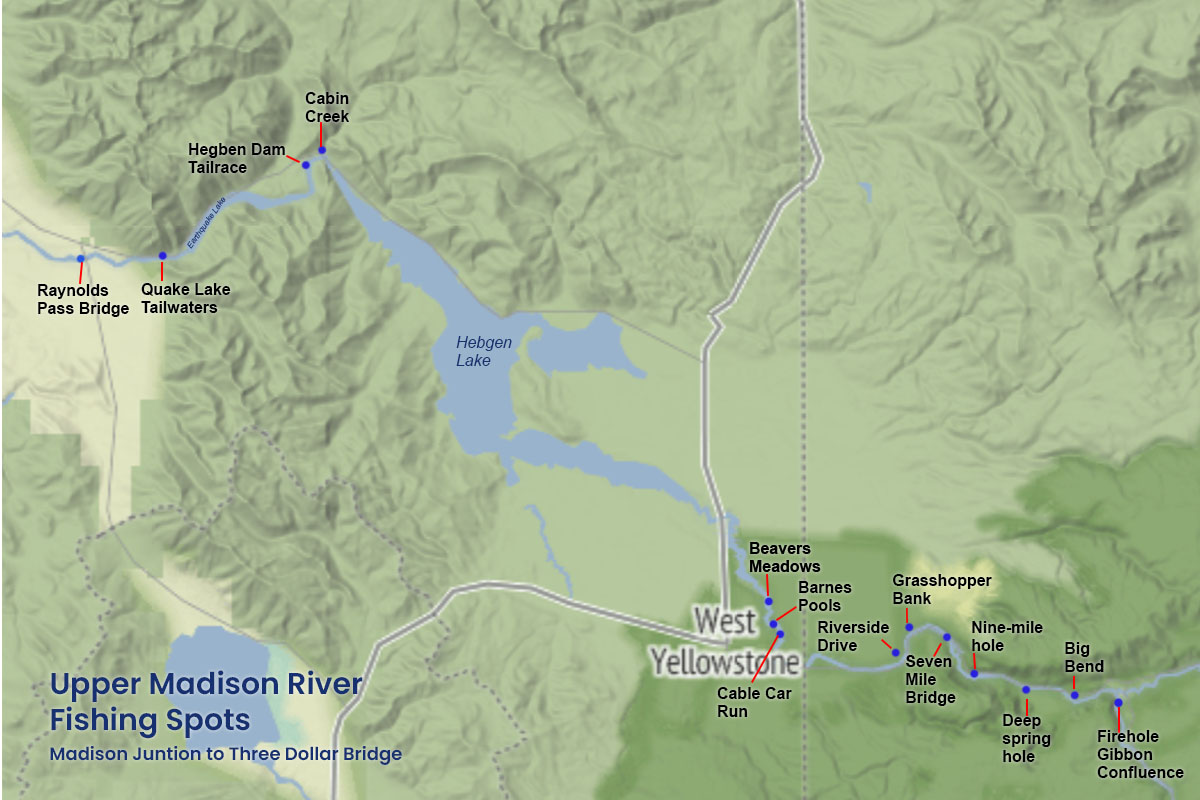
Madison Junction to Riverside Drive
The 9-mile stretch of the Upper Madison from Madison Junction downstream to Riverside Drive is a productive spring and fall fishery where anglers will find resident and migratory trout populations. It’s characterized by deep runs, lush weed bottoms, and deeply undercut banks. Beyond Riverside Dr the river shallows and resident trout populations dwindle.
Fishing this unique 9-mile chalkstream section of the Madison gets underway just after season opening in June and lasts until early July before warming temperatures drive resident trout to seek cooler waters. As water temperatures in the Upper Madison cool in early September, trout once again appear and are active.
Matching the hatch is key to catching trout. June hatches include BWOs, Pale Morning Duns (PMDs), Gray Drakes, Tricos, Salmonflies and Brachycentrus caddis—with PMD and Brachycentrus hatches most prolific. Recommended PMD presentations include emerger, dun, and cripple patterns sizes #16-18. Good caddis patterns include Elk Hair Caddis, Parachute Caddis or X-Caddis sizes #14-16. While unpredictable, June Salmon fly hatches offer the opportunity to target some large trout, so bring along some stonefly patterns just in case.
As fly hatches die down during the mid-summer months of July and August terrestrials become a increasingly important food source for trout. While trout are sparse along this section of the Madison during the summer, the 6 mile stretch between Big Bend and Grasshopper Bank, just before arriving and Riverside Drive, consistently holds some larger trout in the deeper runs. Fishing hoppers along the banks and in between the weed beds along this stretch is most productive.
The river directly below Big Bend tightens and the current pick ups substantially as it flows down a three quarter of a mile riffle before rejoining Highway 191 on its north side. This stretch has very few trout worth targeting, but toward the end of the riffle, where the river rejoins the road, is a deep spring hole that is known to hold a few lunkers. This is a great spot to cast some dry flies or fish a streamer or two.
Just below the deep spring hole is a small bench meadow where the Upper Madison divides in two and runs around either side of an island. There are a number of underbanks and deeper runs along this stretch where anglers stand a good chance of snagging some larger trout.
The bench meadow is followed by another small meadow, a half-mile riffle, and then the river snakes through a marsh before reaching lower Nine Mile Hole. This section of the river offers some panfish, but is otherwise unfishworthy most of the year except during the month of October when Brown trout are running. Moving from lower Nine Mile Hole to Seven Mile Bridge the bank is silty and dangerous for wading.
As fall approaches, the river fills with resident trout as well as migratory trout from Hebgen Lake. The influx in trout doesn’t go unnoticed and anglers arrive to wet their lines and try their hand at hooking a giant rainbow or brown. October is considered one of the best months of the year to fish the Madison River between Madison Junction and Riverside Drive.
Target migratory trout fishing streamers and nymphing. A double dropper nymph rig with a stonefly point and pheasant tail dropper is a lethal combination. While nymphing and streaming will also catch a number of resident trout, fishing the Blue Winged Olive hatches this time of year with a size #16-18 dry fly or emerger is also productive.
In the absence of fly hatches, nymphing deeper pools is going to be your best strategy any time of the year. A rubber leg stonefly, PMD nymph, or Caddis dropper will often generate bites.
Riverside Drive to Yellowstone’s West Entrance
The seven mile stretch of river from Riverside Drive west to the park boundary is mostly unproductive during most months of the year. The best time to fish this section of the Madison is during the fall spawn when migratory trout from Hebgen Lake begin working their way upstream. Fishing pressure is often low during early fall just as migratory trout start entering the river—but picks up quickly.
The river here is characterized by shallow riffles with a few deeper runs. Trout hold in the deep runs and potholes that exist including the three most popular runs: Barnes Pools, Cable Car Runs, and Beaver Meadows. During peak fishing season these runs are full of hungry trout and fishermen. Nymphing and streaming are the most productive techniques, but anglers can also experiment with a variety of dry fly patterns.
Barnes Pools, aka “the Barns Holes”, is a 3-mile stretch of river that provides some of the best trout fishing on the Madison. It can be reached by taking Barnes Hole Rd north until it ends. The road is accessed from Hwy 191 about .9 miles inside Yellowstones west entrance from the north side of the road. About 1 mile in the road forks. The right fork provides access to Barnes Hole Number Two. Follow the left fork an additional .33 miles to reach Hole #1 and #3.
Even though Barnes Pools are locally referred to “holes”, they are in fact deep swift runs. There are about eight of these runs between Cable Car Run, just upstream of Hole #1 and Beaver Meadows located 3 miles further downstream.
The browns and rainbow trout along this stretch feed on a variety of fly hatches and aquatic insects, but their primary forage is the giant stone (“salmon”) fly and yellow stone fly. At maturity, a giant stone fly nymph reaches nearly two inches. A yellow stone fly nymph is just slightly smaller. Your go-to lures for fishing this section of the Madison are giant and yellow stonefly nymph imitations. However, nymphing a Black Woolly Worm or black nymph is also productive. Some anglers fish muddler or sculpin streamers with success.
The final five-mile stretch downtream to Baker’s Hole at Yellowstone’s west boundary is made up of oxbows, flats, glides, and few shallow runs. It is known as Beaver Meadows for the many beaver holes that dot the banks. This is primarily a dry fly fishery, but nymphs and streamers are also effective. Beaver Meadows really only is productive during the fall brown trout migrations. It is accessible by hiking in from Barn’s Pools or Bakers Hole Campground.
Much of the best fishing along this section of the Madison occurs during fall spawn from September through October as big browns make their way upstream. Landing a 4 pound lunker is not uncommon this time of year. A 7-weight rod with IX-2X tippets is an ideal setup for the size of fish you’ll find fishing Beaver Meadows. You’ll also want to have a good variety of nymphs, streamers and bright colored flies.
Hebgen Dam to Earthquake Lake
The two mile tailrace of Hebgen Dam while often overlooked is not be forgotten. This stretch of the Upper Madison, locally referred to as “Between the Lakes”, offers a choice fishery that is home to some enormous trout. The water is here is a cool 40 to 42 degrees year round. The stable flow and temperature provided as a tailwater river ensures a consistent and predictable fishery.
Dry fly fishing mayfly, caddis, and stone fly imitations in its pocket water will typically produce bites from both browns and rainbows. Crane fly larvae and sculpins are another favorite reported by anglers. In the fast water just below the dam nymphs tend to garner most of the action.
Anglers report some of the best catch rates just upstream of the Quake Lake inlet. During spring spawn (Feb-Mar) rainbows migrate up from Quake Lake to spawn just below Cabin Creek in the shallow riffles, with large browns right behind. Browns are especially fond of egg patterns and streamers this time of year.
A few anglers have coined the tailwaters of Hebgen Dam as the “best half mile of [fishing] river in Montana”.
Earthquake Lake to Raynolds Bridge
Below Quake Lake the river runs fast and furious for about 5 miles to Raynolds Pass Bridge. This section of the Madison is appropriated called “The Slide”. Anglers will find good fishing in the pocket water along the edges of the main current. Trout density through the Raynolds Pass fishing access site is high and the average fish size is large. Angling pressure is relatively high during July and August.
Below Quake Lake is catch and release only. Artificial lures must be used. Large stonefly nymphs, terrestrials and sculpin patterns are your go-to presentations for targeting large trout. The late winter and early spring midge and BWO hatches present the best opportunity for dry fly fishing. This section of the Madision is fish from bank only and no boats allowed. The current here is fast and dangerous, so take care when fishing this stretch of the Madison.
When fishing areas with substantial current target the slower waters and eddies behind downed logs and boulders. This is where you’ll find trout holding.
Upper (“Middle”) Madison River
The Upper Madison River between Raynolds Pass Bridge and Ennis Lake is one of the premier fly fishing destinations in the western United States. If every there were a fishery that deserved to be a on every anglers’ bucketlist, this is it. From Hebgen Reservoir to Ennis Lake the Madison fishing access is outstanding with fairy stable flows throughout the fishing season. And best of all, anglers will find fat, happy browns and rainbows along its entire length.
Both wade and float fishing are popular along the Upper Middle Madison, with float fishing the more popular option. Much of this section of the Madison is accessible from bank, but some of the best fishings spots are only accessible from a boat. Hatches are prolific from early March through late fall and matching the hatch is key to maximing catch rate.
Rules and regulations vary along each stretch of the Upper Middle Madison so carrying a current list of regulations is a good idea. The entirety of the upper stretch of the Madision is catch-and-release only for rainbows and several sections are catch-and-release only for browns as well. Kids under 14 can keep one brown or one rainbow. If you’re looking to harvest your catch head to the Lower Madison downstream a bit from Ennis Lake.
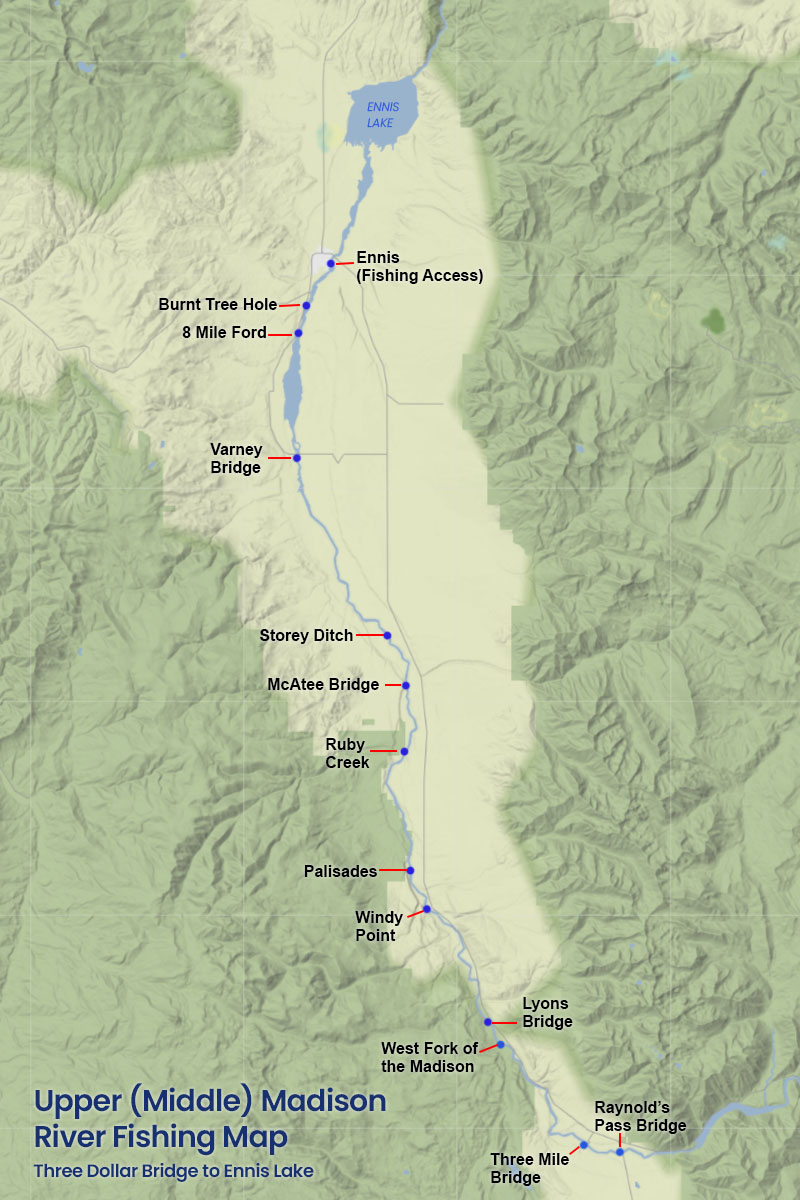
Raynolds Bridge to Lyons Bridge
Fast current, boulder strewn canyons, and pocket fishing continue for about a mile passed Raynolds Bridge. From there the fast water begins to transition into the large riffles the Madison is famous for. At the “big bend” about 3 mile downstream from Raynolds Bridge the river slows and gives way to large riffles with interspersed islands and side channels.
During peak season fishing pressure from Raynold’s Pass Bridge two miles downstream to Three Mile Bridge is relatively high but drops off considerably from there to Lyons Bridge—even though trout populations along the later stretch are still relatively high.
The section of the Upper Middle Madison from Raynolds Pass Bridge to Lyons Bridge is fish from shore or wade fishing only. However, you can still float this section to quickly jump from one run to the next and hit all the best fishing spots.
Lyons Bridge to McAtee Bridge
Downstream from Lyons bridge to Ennis both float or wade fishing are permitted, although this section of the river is best fished by raft or drift boat. Wade fishing traffic along this section of the Madison is light. Popular float routes include Lyons Bridge to Windy Point (6.2 miles), Lyons Bridge to Palisades (7.9 miles), Lyons Bridge to McAtee Bridge (15.3 miles), and Lyons Bridge to Storey Ditch (17.8 miles).
Just upstream from Lyons Bridge the West Fork Madison River enters the main river. At the tail end of May entering early June during years when water is high the West Fork of the Madison brings with it a lot of sediment creating cloudy water down the west side of the Madison for several miles. Downstream from the West Fork confluence anglers will find some of the best trout habit and fishing along the Upper Madison. Trout populations range from 3,000-5,000 per mile and catch rates are high.
A variety for fishing techniques will pull trout from the water. Nymphing, fishing streamers, or dry fly fishing are all productive depending on the time of year. Along this stretch of the Madison anglers will often find trout holding in the “bucket” like pools that form behind the larger boulders and runs.
McAtee Bridge to Varney Bridge
From McAtee Bridge to Varney Bridge the Upper Madison is much the same—one large shallow riffle. This stretch of the river loses some of its previous character and structure. There are fewer islands, boulders, and side channels. Runs are a little more difficult to pinpoint and trout concentration are slightly lower but there are some lunker trout here—especially near the Varney Bridge takeout next to the large cottonwoods.
Although a bit more challenging, the river between McAtee and Varney offers some of the best dry fly fishing on the Madison during the summer months. Fish the current seams, eddies and “bucket” water.
If you want to float this section of the Madison you’ll put in at Storey Ditch, just over 2 miles downriver from McAtee Bridge, and take out at Varney Bridge.
Varney Bridge to Ennis Bridge
This section of the Madison is known for producing some large browns. Toward Ennis the river gains a lot of structure. The shallow riffles upstream from Varney Bridge give way to long runs, channels, and deep undercut banks that are home to some giant browns. For the newcomer it can take a while to learn where the fish are concentrated, but once you find a sweet spot you’ll start landing the trout.
Varney to Ennis can be floated or wade fished, or a combination. Many anglers will float this stretch of the river and get out and wade fish some of the more productive fishing spots and side channels. When flows are high this section of the river is challenging to wade fish.
There are two popular float routes along this stretch of the Madison: Varney Bridge to 8-mile Ford (5.1 miles) and 8-mile Ford to Ennis (4 miles).
Ennis Bridge to the Lake
The Madison below Ennis Bridge is shallow and characterized by multiple braided channels. It is closed to float fishing. During high water it is challenging to wade fish. During mid summer when flows are lower the water can become warm and unfishable. Fishing conditions along this stretch of the river a highly dependent on water flows and vary from year to year.
Public access is available at Ennis Bridge, from the town, and the Valley Garden FAS.
Lower Madison River
The Lower Madison extends from Ennis Dam 30 miles downstream before joining the Gallatin and Jefferson at their confluence with the Missouri River near Three Fork. The upper reaches of the Lower Madison (“Bear Trap Canyon”) is a popular stretch for white water river rafting and float fishing—especially during high flows. Downstream from Bear Trap Canyon, beyond Warm Springs access, the Lower Madison transitions into a wide river with slow moving flows. During May and June when fishing pressure is high in Yellowstone and the Upper Madison, savvy anglers will move downstream to float fish the Lower Madison.
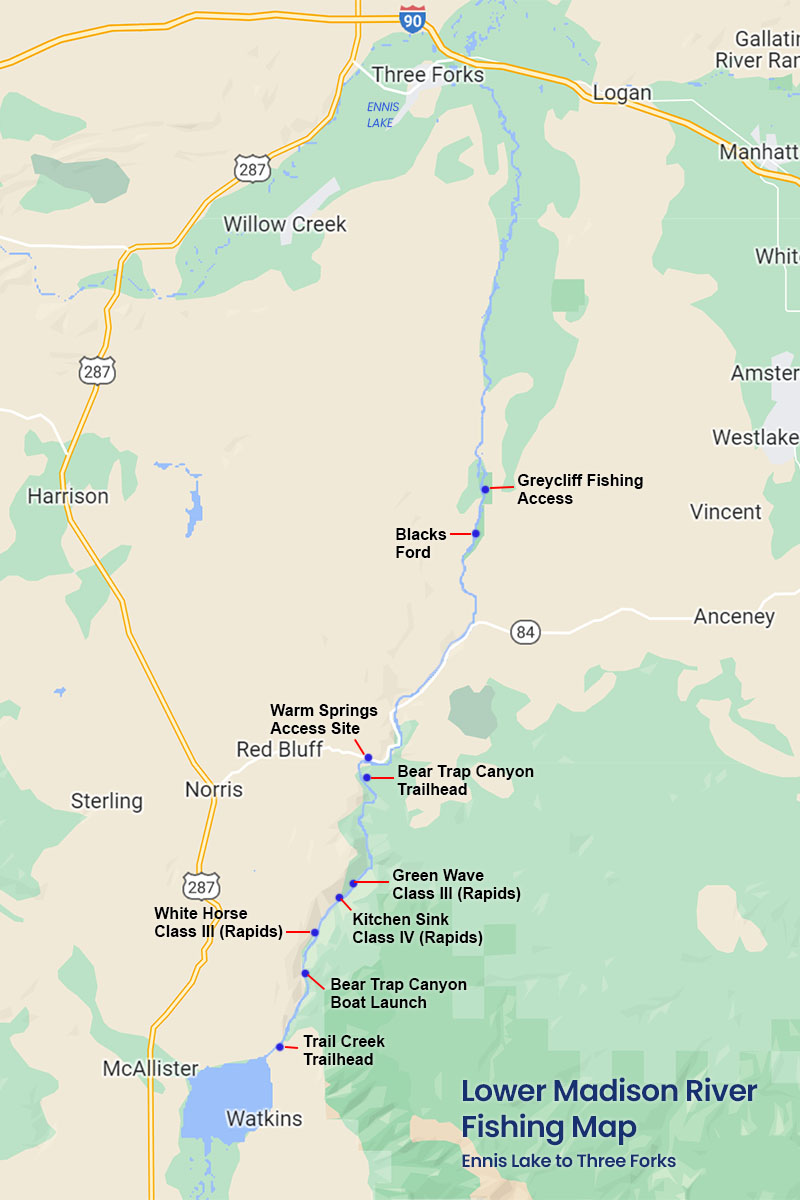
Bear Trap Canyon
After existing Ennis Lake, the Madison river enters Bear Trap Canyon. Bear Trap Canyon is a scenic stretch of the Lower Madison that runs 9 miles through a steep rocky canyon. Although this stretch of the river is less accessible than other parts of the Madison it offers extraordinary trout fishing and has become a favorite fishing destination for many Montana anglers. As a tailwater of Ennis Lake, Bear Trap Canyon remains relatively warm and fishable much of the year.
Bear Trap Canyon can be float fished or fished from shore. The canyon has class V and VI rapids which is enough to keep most boaters out. But for the intrepid angler, Bear Trap Canyon offers some exciting float fishing. A 7.5 mile trail follows the canyon from the trail head south to Ennis Dam along the eastside of the river. The trail head is accessible downstream at Highway 84. It’s a fun hike in that offer some great shore fishing. The best months to fish Bear Trap Canyon are April through June.
If you plan on float fishing the canyon, boater beware. There are few class V rapids between Ennis Dam and the Warm Springs access just off Hwy 84. If you’re inexperienced with this section of the river, it’s advisable not to float the canyon, or hire a professional float guide. There is plenty of good fishing to be had from shore.
Anglers won’t find prolific hatches along the river in Beat Trap Canyon as they will other sections of the Madison, but for a truly exciting angling experience make sure to pay attention to the salmonfly hatch. Fishing nymphs tight up against the banks in the pocket water will land you some big browns.
Early spring and summer hatches along the canyon include Pale Morning Duns, Blue Winged Olives baetis, and Mother’s Day Caddis. If you’re going experiment with dry fly fishing in the canyon, try to match the hatch. However, nymphing and fishing streamers is often more productive since the canyon is filled with crayfish. Trout along this stretch love crayfish imitations. Crayfish are must if you’re going to be fishing the canyon much.
Spoons and spinners in the 1/8—1/4 ounce range are also productive. The key here is presentation. First you want to use a relatively heavy weight so you can do some precision casting and reach the pools and eddies on the far side of the river. Cast straight out or down stream at a 45 to 90 degree angle. This allows the action of the lure to look normal. The spinner will spin against the resistance of the current and the spoon will wobble. If you cast upstream, the presentation doesn’t look natural and you’ll get more snags along the bottom.
Fishing crankbaits in a similar manner can be just as effective. Start by finding a big rock to fish from that has substantial current flowing around it. Make a cast downstream and position your bait in the strike zone and water column just where you want it. Allow the force of the current to hit the lip of the crankbait to create the desired action. Once your bait is positioned, you don’t need to go anywhere. Just allow the current to do the work and wait for a strike. It’s sort of like trolling, but without a boat. This approach is extremely useful up the canyon where the water is deeper, more turbulent and fishing a dry fly is challenging.
Warm Springs access to Greycliff Fishing Access
Most fishing and floating on the Lower Madison occurs between Warm Springs and Black’s Ford or Greycliff fishing access site. Downstream from Greycliff the Madison river begins to warm, trout populations decline, and fishing pressure is relatively low. Even though trout numbers drop off, there are still some big trout on the lower reaches of the Madision between Greycliff and Three Forks.
After leaving Beartrap Canyon, the Madison river dramatically changes character. From Warm Springs access to Blacks Ford the Lower Madison experiences only a slight decline in elevantation and is much wider. The river here is characterized by slow gentle flows, massive weedbeds, and lush aquatic vegetation. Most of the trout along this stretch of the Madison hold in or near the many channels and depressions within or adjacent to the weedbeds. This is where anglers will experience the highest catch rates. Targeting the “bucket” pools and eddies that form behind structure is also productive.
The Lower Madison river is considered a year-round fishery, although the warm summer temperatures do not support good trout fishing. The best months to fish the Lower Madison are late February through early July and mid September through mid December. The Lower Madison also fishes well throughout the winter—weather permitting. For 2-3 weeks in late May during spring melt high water flows can make fishing a bit challenging along some stretches.
The Lower Madison has some prolific hatches. The most common hatches include Blued Winged Olive (baetis), Pale Morning Duns (PMDs), Yellow Sallies, and caddis. Trout can be finicky feeders and anglers will experience the highest catch rates when they match the local hatch. Crayfish are also abundunt along the Lower Madison and a common food source for foraging trout. Fishing crayfish imitations and streamers is one of the most effective methods for hooking some of the bigger trout along the lower stretch of the Madison.
The Lower Madison produces a lot of small to medium-sized trout with a few lunkers here and there. Anglers report a lot of success shallow nymphing and fishing dry fly droppers. Larger trout should be targeted with streamers or deep nymphing.
Fly Fishing Techniques
Even though the Madison boasts one of the highest trout concentrations of any riverine fishery in the region, many fly fishing newbies may find the Madison a bit challenging. Madison trout can be finicky feeders and presentation is key to getting fish here to bite. The three general fly fishing techniques used on the Madison are dry fly fishing, nymphing, and streamer fishing. Each has a time and place. Knowing when, where, and how to employ each technique is key to having a productive fishing experience.
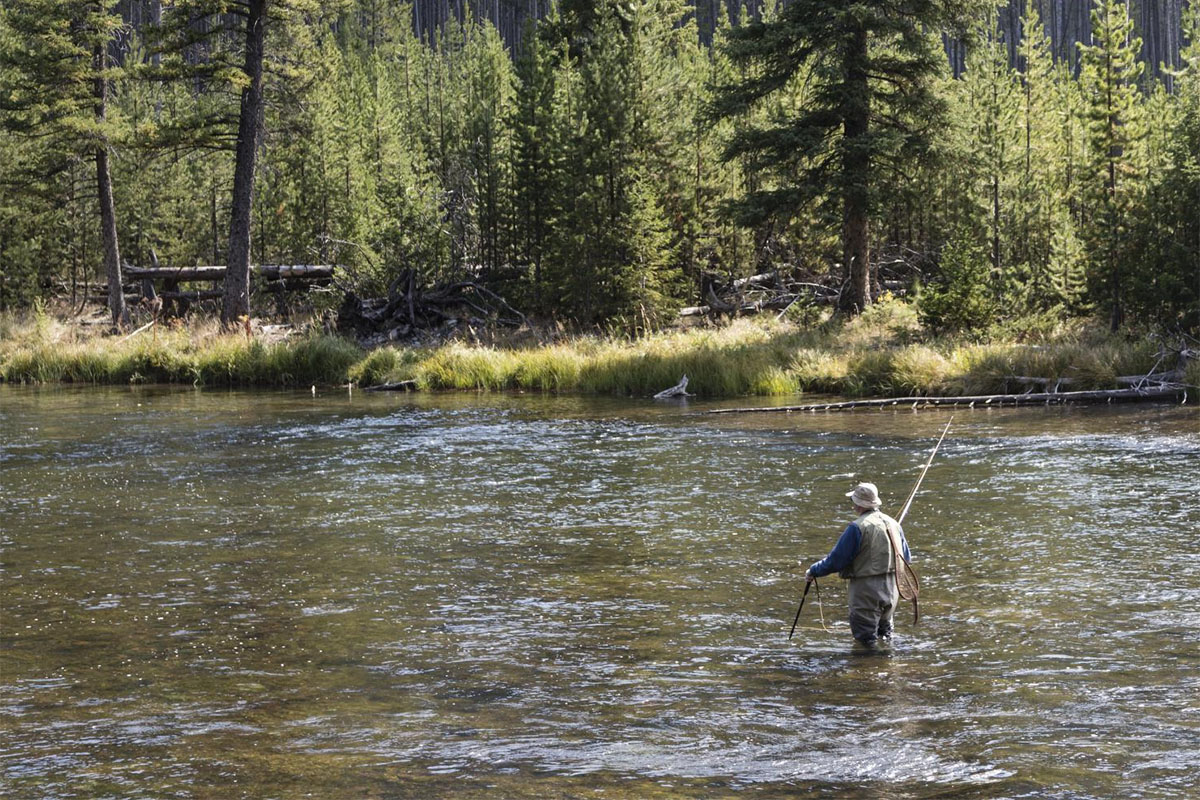
Dry Fly Fishing
While not the most popular technique on the Madison, many an angler will argue dry fly fishing is the most fun. Nothing quite like watching a giant rainbow rise from the depths to break the water’s surface and ingest your fly in one massive gulp. The Madison is flush with hatches and this means there’s always going to be trout feeding at the surface. Match the hatch and you’ll reel in trout. The most common fly hatches on the Madison include salmonflies, Pale Morning Duns (PMDs), caddis, Yellow sallies, golden stoneflies, BWOs and midges. And terrestrials are where the action is at come mid-Summer.
Choosing the right bait is half the battle. The other half—and probably the more important half—is presentation. When it comes to dry fly fishing, presentation is everything. Since most of the Madison is quite shallow, you’ll find trout just about everywhere. The larger your fly the more visible it will be to trout and further they’ll move to take it. But sometimes you’ll want to fish smaller flies.
One of the most productive dry fly fishing techniques for fishing smaller flies on the Madison is dead drifting. Cast your fly to your target zone and let the current do the rest. No need to add any movement or action. Larger fly patterns, including stoneflies and terrestrials, typically need an additional strip or twitch to get trouts’ attention, especially when fishing near mid river.
A few of the best performing dry fly patterns for fishing the Madison include:
- Griffiths gnat #14-18
- Chubby Chernobyl #6-12
- Royal Chubbys #8-14
- Parachute Adams #10-16
- X-Caddis Tan #12-24
- Rogue Foam Stonefly #10-16
- Hedgehog Salmonfly #8
- Royal Stimulator #8-16
- Goddard Caddis #14-18
Nymphing
If your goal is to catch as many trout as possible, nymphing is where it’s at. Most trout pulled from the Madison are caught nymphing either a two-fly indicator nymph rig or double dry fly dropper rig. Aquatic bugs are prolific on the Madison River year round and nymphs are a mainstay of trouts’ diet. If all you ever fished was a nymph, you’d consistently get bites day in and day out. Again, presentation is still key. Drift, depth, fly weight and pattern are all important considerations when nymphing.
Target “bucket” pools and eddies that form behind and alongside larger rocks and boulders. Current edges and transition zones where there are changes in depth are also hot spots for trout activity. Mid-river drop offs and deeper runs are likely holding spots for foraging trout. When water flows are high in early spring, fish towards the banks. During late season experiment in the slower, deeper water. And where you find one trout, you’ll likely find more.
A few of the best performing nymph patterns for fishing the Madison include:
- Rubber leg Stonefly #4-12
- Pheasant tail #14-18
- Prince Nymphs #8-18
- Lightning bug #12-20
- Shop-vac #12-18
- Pat’s rubber legs #8-12
- Serendipity #14-20
- BWO/baetis nymphs #16-18
- San juan worms #6-12
- Midge larva
Streamer Fishing
Streamers are a favorite of big brown trout. If lunker browns or trophy rainbows are your target quarry, big flies and streamers are the name of the game. Early spring, late fall, and overcast summer days provide the best action for streamer fishing. Make sure to bring a good selection of streamers and don’t be afraid to mix it up. Experiment to see what works best for the water you’re fishing.
Your go-to streamer colors for fishing the Madison are olive and tan. On overcast days, or when water clarity is low, darker flies tend to perform well. On brighter days, and when water claritiy is high, brighter flies produce. Smaller streamers generate consistent action and bites. Larger streamers tend to weed out the little fellas and draw in the largest of trout.
Streamers will work just about anywhere there are trout. The key is to keep casting until you find the trout. Undercut banks, potholes, deeper runs, “bucket” water, boulders, and transition zones are all prime real estate for holding trout. Just keep casting and you’ll catch trout.
A few of the best performing streamer patterns for fishing the Madison include:
- Sex Dungeon #2-8
- Mini Dungeon #2-8
- Fat Head #2-8
- Woolhead Sculpin #6-8
- Wooly Bugger #2-12
- Meat Whistle 1/0-3/0
- Sculpzilla #2-8
- Mini-loop sculpin #6-8


